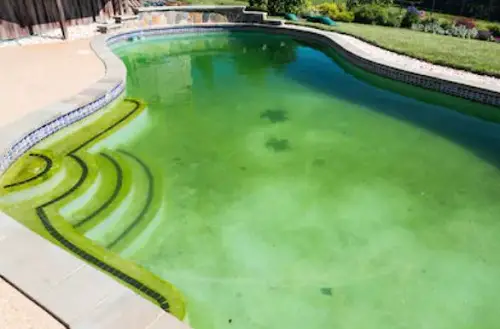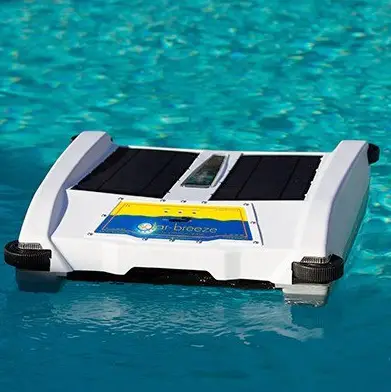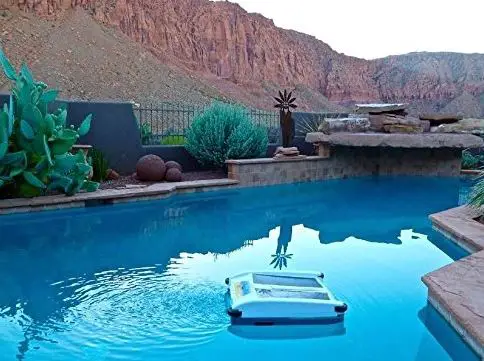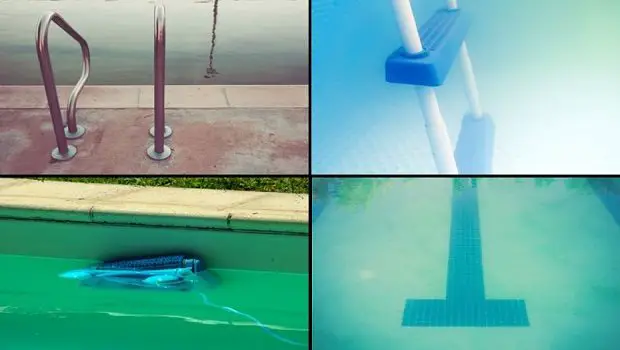How to Clear Cloudy Swimming Pool Water: 3 Simple & Proven Tricks
DISCLOSURE: As an Amazon Associate, I earn from qualifying purchases.
“Cloudy” is a pretty vague term, and there are various stages of cloudy pool water. Also, it goes from bad to worse.
It can be broken down into three classes:
Flat. The least severe kind, in that your pool water, yet has its color, but it does not have the sparkle it once did.
Hazy. The water is beginning to lose the color it, and it is now hard to make out details on the pool floor.
Milky. The water is translucent, meaning that the pool floor isn’t visible. This is quite as bad as it gets.
What Causes Cloudy Pool Water?

There are several reasons your pool water can become cloudy, and understanding that the potential cause will not only help you mend it but also prevent it in the future.
So let’s talk about methods to fix the root of the issue before treating the symptoms — since we’re not about to slap on a bandaid and call it a day.
Here we go.
Cause #1: Improper Pool Chemicals
If you did not pay attention to your school chemistry lessons, it might be a chemical imbalance in the water. (In actual, this is one of the most frequent causes of a cloudy pool )
Having too much quantity of one chemical or not sufficient of another is the fast-track ticket to a muddy pool, so assessing your pool chemistry for high pH, total alkalinity and chlorine levels is always a fantastic place to start.
Is Your pH Level Right?
The optimal pH level for your pool water is around 7.2 and 7.6 on the pH scale, which leads to being a little bit alkaline.
Your water won’t turn muddy only because your pH level is out of the range, but it is going to stop your pool chemicals from doing their job correctly, causing particles to linger that will eventually result in a cloudy pool.
Measuring the pH level of your pool is straightforward using the right test kit, so ensure that you do that weekly to remain on top of any sudden changes.
Is Your Chlorine Level Accurate?
You want chlorine in your pool to fight off nasty bacteria and other germs, but the amount you use should not be overlooked.
The “sweet spot” is within 1 and 3 ppm (parts per million). This keeps your water clean but prevents it from turning cloudy — considering everything else is balanced.
Exactly just how much depends on how frequently your pool is used, how busy it gets, and the weather it is exposed to. (The sun will “process” your chlorine, converting it into gasoline and making your chlorine level to drop quicker.)
Is Your Alkalinity Level Too High?
Alkalinity, or Total Alkalinity, is a pH buffer that absorbs changes in the water to keep your pH level stable. However, it may cause your water to turn cloudy if your alkalinity is high.
Once again, most pool test kits will enable you to test for alkalinity, and you will typically need this to be between 80 and 120 parts per million (ppm), or 100 and 140 parts per million for vinyl, painted, and fiberglass inground pools.
You can use dry acid (sodium bisulfate) or muriatic acid (hydrochloric acid) to lower alkalinity though fatty acid has some undesirable side effects.
Is Your Calcium Hardness Too High?
Magnesium hardness is a measure of how much calcium is in the water, with the suggested range being somewhere within 200 ppm to 400 ppm.
While low calcium hardness levels can lead to damage to your pool fittings, it is the opposite side of the spectrum you want to be concerned with here. High levels of calcium hardness result in excess calcium, which ultimately results in scaling and cloudy water.
Unfortunately, most test strips will not contain calcium hardness, so you will want to use a liquid test kit instead.
If you notice that your calcium hardness level is too high, the best option is to replace some of your pool water. If you are unable to do that, you can use pool flocculant to remove the extra calcium, but it will need a manual clean-up afterward.
Cause #2: Circulation & Filtration Issues
Pool water that is not being well circulated is always had the possibility of becoming cloudy.
That’s because circulation accelerates your pool water through your filter system, so without it, the filter can’t work it’s magic and maintain your water squeaky clean.
There are a few moving components to this, so let’s go through them.
Is Your Pump Strong Enough?
A pool pump is a core element of your filtration system as it cycles your water through the filter to eliminate debris and keep circulation. This blocks the water from stagnating, which eventually causes other difficulties.
Keeping that in mind, you will have to ensure that your pump can cycle the intact contents of your pool at least once each day. What’s more, you will require a pump that can perform a turnover in 8 hours.
The speed at which a pump finishes a turnover relies on two factors:
- The volume of water in your pool (utilize this calculator)
- The flow-rate of the pump itself (this is mentioned in the product specifications of any pool pump)
To accurately size your pump, divide your water volume by 8, then divide it again by 60. What you are left with is your pools needed turnover rate in GPM. The flow-rate of your swimming pool pump should be at least the same.
Is Your Pump Suited For Your Filter?
You wouldn’t put all that effort into accurately sizing your pool pump only to ignore your pool filter, would you?
If your pump is too reliable for your filter, it is going to end up pushing more water than the filter can manage. This bottleneck not only keeps the water from being properly cleaned, but it can also cause physical harm to your filtration system.
Pool filters share a comparable rating system to pool pumps since they’re rated in gallons per minute (GPM) per square foot. Your filter should have the same rating as to your swimming pool pump.
Do You Properly Maintain Your Equipment?
This is one of those “duh!” suggestions that people skim over, but you would be amazed by how often primary pool care is overlooked.
Your pool gear is the first line of defense, so ensuring it runs effectively should be on top of your list. That includes identifying and regular cleaning, remove blockages, and timely part-replacements.
Cause #3: Environmental Effects
If your cloudy pool doesn’t have anything to do with the filter system or the chemicals, then the only reasonable explanation it’s being caused by the surrounding atmosphere.
Yep, Mother Nature can be a real b*tch often. Here are some of the possible environmental causes:
Leaves & Small Debris
While leaves will be simple enough to remove before they make your water dirty, it’s the buildup of small dust and particles that can create a problem for you.
Small Animals & Insects
Insects and Creatures will find their way to your pool eventually. However, the main thing to keep an eye out for is droppings, especially bird poop.
The Dreaded Algae
Insects and Creatures will find their way to your pool eventually. However, the main thing to keep an eye out for is droppings, especially bird poop.
Surface Runoff
Heavy rain can lead to water to collect on the floor, in some cases making it’s way to your pool bringing tons of other nasties with it (depending upon your pool type and installation ).
How To Clear A Cloudy Pool

Skimmer
Now that we have looked at (and hopefully identified) the possible cause for your cloudy pool water let us talk about clearing this up.
There are multiple ways to clear cloudy pool water, so, in the usual Poolonomics style, let’s classified them down one-by-one.
Method #1: Utilizing Swimming Pool Clarifier
A pool clarifier is a chemical that is used to clean up your pool water.
How do they make it?
Well, it works through a procedure known as “coagulation,” and it is not as complicated as it seems.
Cloudy pool water is a buildup of small particles, and your filter can have a hard time catching those because of their size — but that’s why coagulation is beneficial.
Coagulation helps your filter by clumping those tiny particles together, making them much easier to lift which will clear a cloudy pool.
Method #2: Using Pool Flocculant
When it is about pool chemistry, pool flocculant operates similarly to pool clarifier in that it clumps those annoying particles together to make them simple to eliminate, except it does have one distinct difference.
Rather than work with your filter to ultimately eliminate the particle clumps, flocculant takes them to the base of your pool, where they’ll require to be removed via vacuuming.
There are a few important things to note about this procedure:
- Manual: You won’t have the ability to use an automatic pool vacuum cleaner to try it; it will have to be performed manually.
- Water: As you vacuum out the cloud particles, you will naturally lose a substantial quantity of water, so it is a fantastic idea to keep the hose running as you are doing this.
- Filter: It should take about half a day to clean out the debris from the bottom of your pool, during which stage your filter should be turned off
Why would you need to go this route?
Well, simply put, it will clear a cloudy pool pretty quickly. If you’re in a rush to clear a cloudy pool for any reason, this is the way to go.
Method #3: Helping Your Filter
The last way is just allowing your filter to clean up the dirt.
We all know how valuable filters are for swimming pools, though we also know they can’t work properly without a bit of help from time to time.
An excellent example of this is the skimmer, which operates in harmony with your pool filter to take off the trash from the surface of the pool.
The problem, in this case, is, though, is that the cloud particles will not be drifting to the surface. Not without a little nudge, at least.
You can do this in two manners:
#1: Stir It Just Like A Cup Of Tea
This one includes getting your large spoon out and stirring your pool like the BFG. Just kidding. (But sincerely, you could do that if you had a large spoon.)
Ideally, though, you will want to use a pool brush to get the particles in motion and finally pushed into the top pool. That way, your filter, and skimmer can do their thang.
#2: Suck It Up With Your Drains
If you have an inground pool with a bottom drain, you do have another option that is less labor-intensive.
Your bottom drain will enable your filter to pull water from the pool floor, at the same time carrying a flow of clean water to the surface — basically giving you the same effect.
If you don’t have a bottom drain, there is a little hack you can use that functions with above ground pools.
That’s A Wrap!

No one likes waking up to a cloudy pool, but it does not need to be as devastating as many first-timers think.
The methods outlined above are by far the simplest and most affordable ways to clear a cloudy pool, and also keep it from happening again in the future.
All the best and happy swimming!







One Response to How to Clear Cloudy Swimming Pool Water: 3 Simple & Proven Tricks